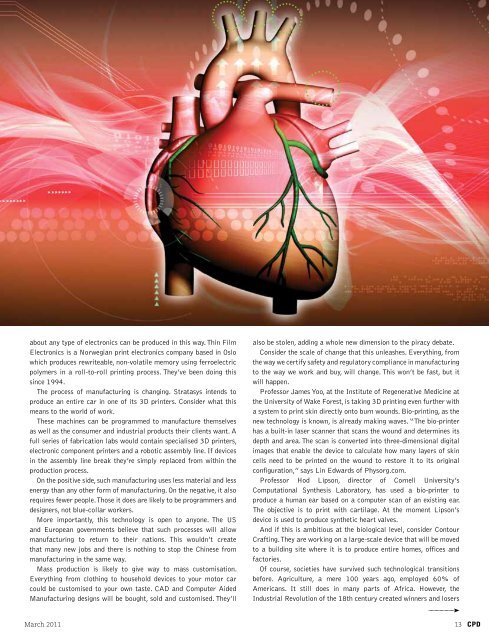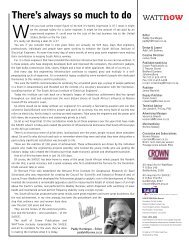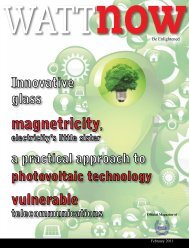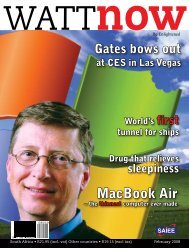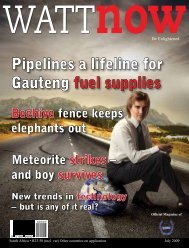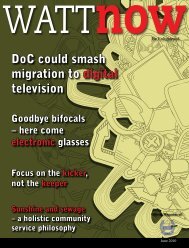download a PDF of the full March 2011 issue - Wattnow
download a PDF of the full March 2011 issue - Wattnow
download a PDF of the full March 2011 issue - Wattnow
- No tags were found...
Create successful ePaper yourself
Turn your PDF publications into a flip-book with our unique Google optimized e-Paper software.
WWatt’s Scienceabout any type <strong>of</strong> electronics can be produced in this way. Thin FilmElectronics is a Norwegian print electronics company based in Oslowhich produces rewriteable, non-volatile memory using ferroelectricpolymers in a roll-to-roll printing process. They’ve been doing thissince 1994.The process <strong>of</strong> manufacturing is changing. Stratasys intends toproduce an entire car in one <strong>of</strong> its 3D printers. Consider what thismeans to <strong>the</strong> world <strong>of</strong> work.These machines can be programmed to manufacture <strong>the</strong>mselvesas well as <strong>the</strong> consumer and industrial products <strong>the</strong>ir clients want. A<strong>full</strong> series <strong>of</strong> fabrication labs would contain specialised 3D printers,electronic component printers and a robotic assembly line. If devicesin <strong>the</strong> assembly line break <strong>the</strong>y’re simply replaced from within <strong>the</strong>production process.On <strong>the</strong> positive side, such manufacturing uses less material and lessenergy than any o<strong>the</strong>r form <strong>of</strong> manufacturing. On <strong>the</strong> negative, it alsorequires fewer people. Those it does are likely to be programmers anddesigners, not blue-collar workers.More importantly, this technology is open to anyone. The USand European governments believe that such processes will allowmanufacturing to return to <strong>the</strong>ir nations. This wouldn’t createthat many new jobs and <strong>the</strong>re is nothing to stop <strong>the</strong> Chinese frommanufacturing in <strong>the</strong> same way.Mass production is likely to give way to mass customisation.Everything from clothing to household devices to your motor carcould be customised to your own taste. CAD and Computer AidedManufacturing designs will be bought, sold and customised. They’llalso be stolen, adding a whole new dimension to <strong>the</strong> piracy debate.Consider <strong>the</strong> scale <strong>of</strong> change that this unleashes. Everything, from<strong>the</strong> way we certify safety and regulatory compliance in manufacturingto <strong>the</strong> way we work and buy, will change. This won’t be fast, but itwill happen.Pr<strong>of</strong>essor James Yoo, at <strong>the</strong> Institute <strong>of</strong> Regenerative Medicine at<strong>the</strong> University <strong>of</strong> Wake Forest, is taking 3D printing even fur<strong>the</strong>r witha system to print skin directly onto burn wounds. Bio-printing, as <strong>the</strong>new technology is known, is already making waves. “The bio-printerhas a built-in laser scanner that scans <strong>the</strong> wound and determines itsdepth and area. The scan is converted into three-dimensional digitalimages that enable <strong>the</strong> device to calculate how many layers <strong>of</strong> skincells need to be printed on <strong>the</strong> wound to restore it to its originalconfiguration,” says Lin Edwards <strong>of</strong> Physorg.com.Pr<strong>of</strong>essor Hod Lipson, director <strong>of</strong> Cornell University’sComputational Syn<strong>the</strong>sis Laboratory, has used a bio-printer toproduce a human ear based on a computer scan <strong>of</strong> an existing ear.The objective is to print with cartilage. At <strong>the</strong> moment Lipson’sdevice is used to produce syn<strong>the</strong>tic heart valves.And if this is ambitious at <strong>the</strong> biological level, consider ContourCrafting. They are working on a large-scale device that will be movedto a building site where it is to produce entire homes, <strong>of</strong>fices andfactories.Of course, societies have survived such technological transitionsbefore. Agriculture, a mere 100 years ago, employed 60% <strong>of</strong>Americans. It still does in many parts <strong>of</strong> Africa. However, <strong>the</strong>Industrial Revolution <strong>of</strong> <strong>the</strong> 18th century created winners and losers<strong>March</strong> <strong>2011</strong> 13


